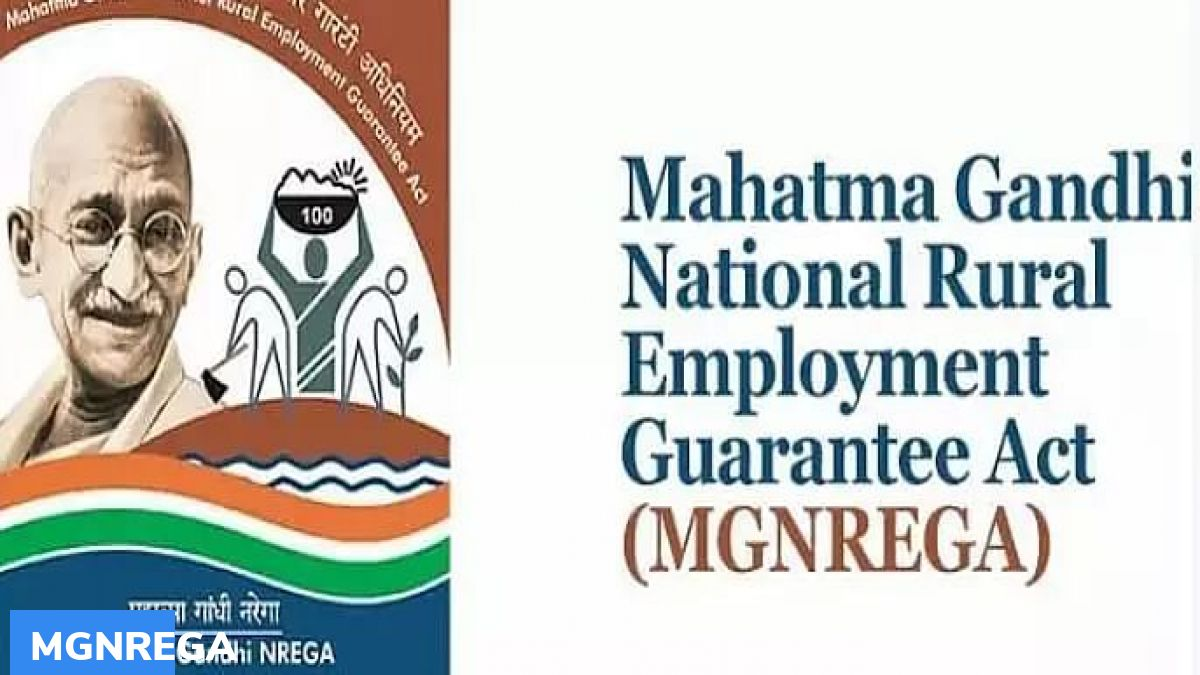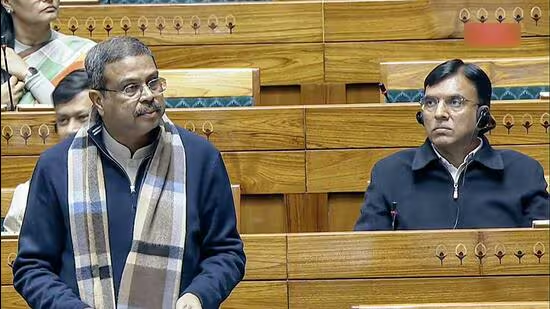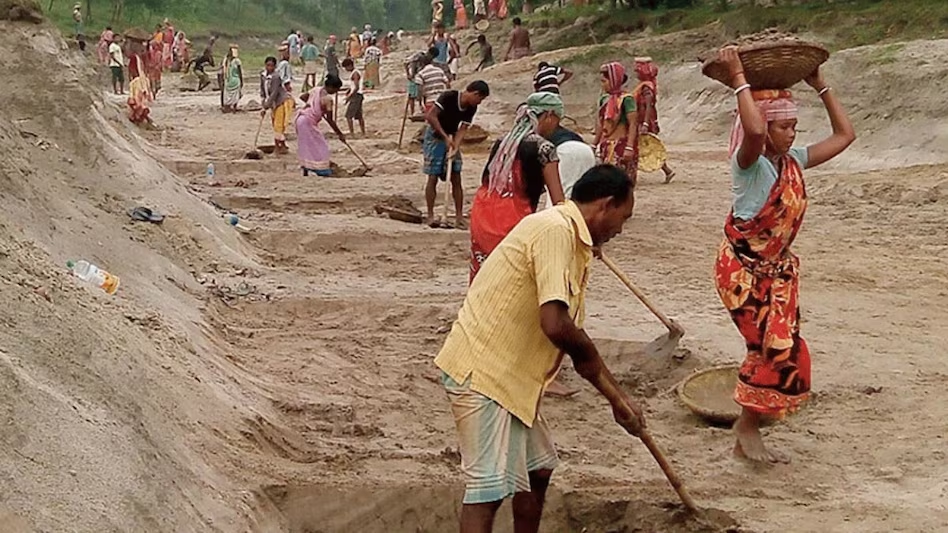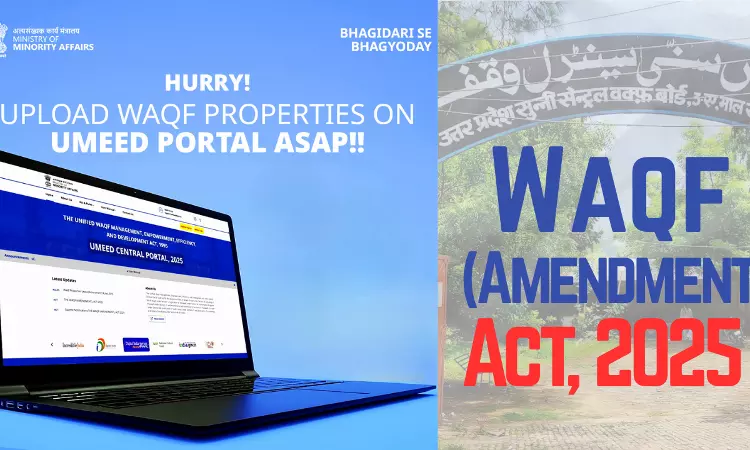
Copyright infringement not intended
Picture Courtesy: jagran.com
Context: The fourth extension for mandatory payments under the Mahatma Gandhi National Rural Employment Guarantee Scheme (MGNREGS) through the Aadhaar-based Payments System (ABPS) is set to end on August 31. The Ministry of Rural Development has stated that there won't be any more extensions.
Key Highlights
- The Mahatma Gandhi National Rural Employment Guarantee Scheme (MGNREGS) is a social security and employment generation program in India. It aims to provide guaranteed employment to rural citizens.
- The Aadhaar-based Payments System (ABPS) is a method of disbursing payments to MGNREGS workers using their unique 12-digit Aadhaar number as their financial address.
- ABPS Process: For ABPS payments, a worker's Aadhaar details must be linked with their job card and bank account. This information needs to be integrated with the National Payments Corporation of India (NPCI) database, including the bank's Institutional Identification Number (IIN).
- Ineligibility Statistics: Out of a total of 26 crore job card holders (individuals registered for the MGNREGS), 41.1% are not eligible for receiving payments through ABPS. Among the 14.4 crore active workers, only 18.3% are ineligible for ABPS payments.
- Variation across States: The percentage of ineligibility among active workers varies from state to state. In the top five states with active MGNREGS workers (Uttar Pradesh, Bihar, West Bengal, Madhya Pradesh, Rajasthan), around 1.2 crore workers will no longer be eligible for ABPS payments due to the absence of ABPS-enabled accounts.
- In Northeast India, the situation is dire. For instance, in Assam, where there are more than 63 lakh workers, 61.2% are not eligible for ABPS payments. In Nagaland, with 6 lakh beneficiaries, nearly 80% lack an ABPS account.
- Government's Claims v/s Research: The government argues that ABPS accounts help prevent leaks, ensure quicker payments, and reduce rejections. However, a research paper authored by scholars affiliated with the non-profit organization LibTech India challenges these claims. The paper analyzes 31.36 million transactions across 10 states, comparing payments to normal accounts with Aadhaar-linked accounts.
- Research Findings: According to the research, there is no statistically significant difference in the processing time between normal account payments and ABPS payments. Similarly, the research suggests that there is no significant difference in the rate of payment rejections between the two payment types.
- Challenges Faced by Workers: Despite the government's claims, anecdotal evidence suggests that ABPS payments pose challenges for workers. Issues include payments being diverted to the wrong accounts of the same worker or misdirected to different account holders due to Aadhaar-linking errors.
While the ABPS was introduced to improve payment efficiency and reduce leaks, research indicates that its benefits might not be as substantial as claimed. The situation is particularly challenging in certain states and regions, where a significant percentage of workers are ineligible for ABPS payments.

MGNREGA Payments through Aadhaar-based Payments System (ABPS)
About
- The Mahatma Gandhi National Rural Employment Guarantee Act (MGNREGA) is a landmark social security and employment generation program in India. Enacted in 2005, it guarantees 100 days of wage employment in a financial year to rural households whose adult members volunteer to do unskilled manual work. To streamline payment disbursal and ensure transparency, the program has transitioned to an Aadhaar-based Payments System (ABPS).
Features of ABPS in MGNREGA Payments
Aadhaar Integration
- Purpose: ABPS utilizes the unique 12-digit Aadhaar number as a financial address for beneficiaries. This integration serves to accurately identify and authenticate individuals, reducing the possibility of fraudulent claims by duplicate or ghost beneficiaries.
- Beneficiary Verification: When beneficiaries' Aadhaar numbers are linked to their MGNREGA job cards, it becomes possible to verify the authenticity of the beneficiaries, ensuring that only eligible individuals receive payments.
- Elimination of Duplicates: By integrating Aadhaar, the system can identify cases where individuals have multiple job cards in different locations or under different names, preventing duplicate claims.
Seeding of Aadhaar and Bank Account
- Data Linkage: The process involves linking the beneficiaries' Aadhaar details with their respective bank accounts. This ensures a direct connection between the beneficiary's identity and their financial account.
- Accurate Payment Disbursement: The linkage minimizes the chances of misdirected payments and ensures that the wages earned under MGNREGA are credited to the correct beneficiaries' accounts.
National Payments Corporation of India (NPCI) Database
- Data Centralization: The Aadhaar and bank account information, along with the bank's Institutional Identification Number (IIN), are integrated into the NPCI database.
- Fund Transfers: This integration allows for seamless and secure electronic fund transfers from the government treasury to the beneficiaries' bank accounts using the Aadhaar-linked details.
Speedy and Direct Payments
- Timely Disbursements: ABPS aims to accelerate the payment process, reducing the time lag between the completion of work under MGNREGA and the actual receipt of wages.
- Direct Fund Transfer: Payments are directly credited to the beneficiaries' bank accounts, eliminating the need for intermediaries and physical handling of cash or checks.
- Minimized Delays: By removing intermediaries and paper-based processes, delays caused by administrative bottlenecks are minimized, ensuring that beneficiaries receive their wages promptly.
Significance of ABPS in MGNREGA Payments
Transparency
- Direct Beneficiary Payments: ABPS ensures that payments are directly credited to beneficiaries' bank accounts. This eliminates the involvement of intermediaries, reducing the risk of funds being diverted or misused.
- Transaction Traceability: The ABPS system provides a clear audit trail, allowing authorities to track the movement of funds from the government treasury to beneficiaries' accounts. This level of traceability enhances accountability and transparency in fund disbursement.
Reduced Leakages
- Prevention of Ghost Beneficiaries: With the requirement of Aadhaar authentication, ABPS helps in identifying genuine beneficiaries. This prevents the inclusion of fictitious or non-existent beneficiaries, which can lead to leakages and misallocation of resources.
- Minimized Corruption: The direct transfer of funds to bank accounts through ABPS reduces the opportunity for corrupt practices that might occur when cash payments are made, ensuring that funds reach the intended recipients.
Financial Inclusion
- Bank Account Requirement: ABPS mandates beneficiaries to have bank accounts, promoting financial inclusion. This encourages rural households to participate in the formal banking system, opening doors to various financial services.
- Savings and Access to Credit: Bank accounts enable beneficiaries to save money securely and access credit when needed. This empowers rural households to manage their finances and invest in income-generating activities.
Data Accuracy
- Reliable Beneficiary Data: Integrating Aadhaar with beneficiaries' job cards and bank accounts creates a comprehensive and accurate database. This accurate data is essential for efficient program planning, targeted resource allocation, and effective implementation.
- Reduced Errors: By automating the payment process and eliminating manual data entry, ABPS minimizes errors that can arise from traditional paper-based record-keeping methods
Accuracy and Transparency
- Efficient Fund Allocation: The integration of Aadhaar ensures that payments are directed to the correct beneficiaries, reducing errors in the allocation of funds. This accurate fund allocation ensures that those who deserve the benefits receive them.
- Real-time Tracking: Authorities can monitor payment transactions in real-time, ensuring that funds are not misused or diverted along the way.
Operational Efficiency
- Faster Disbursements: ABPS accelerates payment disbursal, providing beneficiaries with quicker access to their wages upon completing MGNREGA work. This timely disbursement helps fulfil the program's social safety net objectives.
- Administrative Streamlining: By automating payment processes and eliminating the need for physical handling of funds, ABPS reduces paperwork and administrative burden, leading to more efficient operations.
Technology Adoption
- Digital Literacy: The use of ABPS encourages beneficiaries to become more familiar with digital technologies, promoting digital literacy in rural areas and enhancing their capacity to engage in digital transactions.
- Government's Digital Agenda: ABPS aligns with the government's broader digitization initiatives, contributing to the goal of transforming rural areas through the adoption of technology and e-governance.
Steps Taken for ABPS Implementation
Aadhaar Enrollment
- Massive Drive: The government undertook a massive Aadhaar enrollment drive in rural areas to ensure that all MGNREGA beneficiaries were registered with unique Aadhaar numbers.
- Unique Identification: Aadhaar enrollment provided each beneficiary with a unique 12-digit Aadhaar number linked to their biometric and demographic information.
Aadhaar-Bank Linkage
- Beneficiary Authentication: Beneficiaries' Aadhaar numbers were linked with their respective bank accounts. This linkage was essential for accurate and secure identification during payment disbursement.
- Bank Account Verification: The linkage also involved verifying the authenticity of the bank accounts, ensuring that they belonged to the legitimate beneficiaries.
NPCI Integration
- Data Integration: The Aadhaar details of beneficiaries and their bank account information, along with the bank's Institutional Identification Number (IIN), were integrated into the National Payments Corporation of India (NPCI) database.
- Electronic Fund Transfer: The integration allowed for seamless electronic fund transfers directly from the government treasury to beneficiaries' bank accounts. This streamlined process reduced delays and administrative overhead.
Training and Awareness
- Beneficiary Education: Beneficiaries were educated about the ABPS and its benefits. This included information about the requirement of linking Aadhaar with bank accounts and the process of receiving payments through the new system.
- Process Explanation: Detailed instructions were provided to beneficiaries on how to authenticate themselves using Aadhaar and how to access the funds credited to their bank accounts.
- Awareness Campaigns: Government agencies, non-governmental organizations (NGOs), and community leaders played a role in organizing awareness campaigns to ensure that beneficiaries were well-informed about the changes in the payment system.
Challenges associated with the implementation
Exclusion Errors
- Aadhaar Linkage Issues: Some genuine beneficiaries may face difficulties in linking their Aadhaar numbers with their bank accounts or job cards. This can result in their exclusion from the payment system.
- Biometric Authentication Failures: Technical issues or changes in biometric features can lead to authentication failures, preventing beneficiaries from accessing their payments.
- Data Entry Errors: Mistakes made during data entry or verification can result in incorrect Aadhaar linkage, causing beneficiaries to be left out.
Technological Challenges
- Poor Internet Connectivity: In rural areas with inadequate internet infrastructure, beneficiaries may struggle with online processes, including Aadhaar authentication and accessing digital payments.
- Digital Literacy: A limited understanding of digital technology among beneficiaries can hinder their ability to navigate through the processes involved in ABPS, leading to confusion and delays
Privacy Concerns
- Data Security: Concerns have been raised about the security of Aadhaar data, including biometric information. There are worries about potential data breaches or misuse of personal information.
- Consent and Control: Some beneficiaries may be uncomfortable with the mandatory collection and linkage of biometric data, raising questions about their consent and control over their personal information.
Dependency on Aadhaar
- Exclusion Risk: Sole reliance on Aadhaar for payment authentication poses a risk. If beneficiaries face issues with Aadhaar enrollment or authentication, they might be excluded from receiving payments.
- System Glitches: Technical glitches or failures in the Aadhaar authentication system could disrupt payment processes, leaving beneficiaries without access to their wages.
Way forward to address challenges and ensure the effective implementation
Improving Implementation
- Grievance Redressal: Establish a robust and efficient grievance redressal mechanism that allows beneficiaries to report issues related to Aadhaar linkage, authentication failures, and exclusion errors. Prompt resolution of grievances is essential to prevent beneficiaries from being left without support.
- Biometric Alternatives: Explore alternatives to biometric authentication, such as using mobile numbers or other identifying information, for beneficiaries who face difficulties with biometrics.
Hybrid Approaches
- Backup Payment Modes: Develop hybrid payment models that allow for multiple modes of authentication and payment. This ensures that beneficiaries have alternative methods to receive payments in case of Aadhaar-related challenges.
- Multiple Channels: Introduce diverse payment channels, including mobile banking, smart cards, or even local banking correspondents, to cater to beneficiaries with varying levels of digital literacy.
Technological Infrastructure
- Digital Connectivity: Invest in improving digital infrastructure, particularly internet connectivity, in rural areas. This enables beneficiaries to access online processes seamlessly, including Aadhaar authentication and digital payments.
- Training and Support: Alongside infrastructure development, provide training and support to beneficiaries to enhance their digital literacy and enable them to navigate the digital payment ecosystem effectively.
Data Security and Privacy
- Data Encryption: Employ strong encryption techniques to secure beneficiaries' Aadhaar and financial information during transmission and storage.
- Privacy Guidelines: Adhere to stringent privacy guidelines and regulations while collecting, storing, and using biometric and personal data. Transparency about data usage and consent is essential to build trust among beneficiaries.
Continuous Evaluation
- Impact Assessment: Regularly assess the impact of ABPS on MGNREGA payments. Evaluate whether the system is achieving its intended goals of transparency, efficiency, and reduced leakages.
- Beneficiary Feedback: Gather feedback directly from beneficiaries to understand their experiences with the payment system, identify pain points, and implement necessary improvements.
Collaborative Approach
- Stakeholder Engagement: Engage with stakeholders, including government agencies, NGOs, financial institutions, and technology experts, to collectively address challenges and develop innovative solutions.
- Local Context Sensitivity: Tailor solutions to the specific needs and challenges of different regions, considering factors such as local connectivity, cultural aspects, and beneficiary demographics.
- Adaptive Policies: Continuously adopt policies based on learnings from implementation experiences. Be open to policy adjustments that address emerging challenges and ensure inclusivity.

Conclusion
- The Aadhaar-based Payments System was introduced to improve the transparency, efficiency, and accountability of MGNREGA, a program that provides rural employment and livelihood security. However, the implementation of this system has faced several challenges, such as technical glitches, authentication failures, and exclusion errors. To address these problems, the system needs to be constantly monitored, evaluated, and improved, so that the intended benefits of MGNREGA can be realized by the eligible beneficiaries.
Must Read Articles:
MGNREGS: https://www.iasgyan.in/daily-current-affairs/mgnregs-37
AADHAAR-ENABLED PAYMENT SYSTEM: https://www.iasgyan.in/daily-current-affairs/aadhaar-enabled-payment-system
|
PRACTICE QUESTION
Q. "What are the distinctive features of the Aadhaar-based Payments System (ABPS) integrated into MGNREGA payments? How does ABPS contribute to the transparency and reduced leakages in the MGNREGA program? What challenges arise from the implementation of ABPS in MGNREGA, and how can these challenges be addressed to pave the way forward for a more efficient and inclusive ABPS implementation?
|
https://epaper.thehindu.com/ccidist-ws/th/th_delhi/issues/49773/OPS/GBTBMC0IV.1+GL6BMC3G7.1.html










